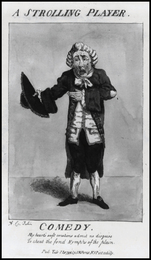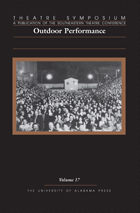
For centuries scholars, philosophers, and practitioners have attempted to explain just what constitutes comedy, and though no one has come close to a definitive explanation, each attempt highlights some distinct facet of the genre--the genre that Woody Allen has said eats at the children’s table . . . even in the world of scholarship.
The essays gathered in Volume 16 of the annual journal Theatre Symposium illustrate well the range of material that falls under the heading “comedy” as it is played on stage.
Stanley Longman’s essay on “The Commedia dell’Arte as the Quintessence of Comedy” introduces us to the inhabitants of “Commediatown,” character types who are descendents of the Greeks and ancestors, it seems, of almost everyone who came after. Boris Senker, an eyewitness to Croatia’s evolution from communism to democracy, reports on the all-too-real "Commedia" stereotypes that have found their way onto the stage in his homeland.
Other essays address the improvisational nature of "Commedia"; the roots of laughter and the expectations inherent in presenting “old schtick” to a new generation; comedic technique, verbal and physical, in Molière; the use of the macabre to create humor in the "Théâtre du Grand Guignol"; the story of Henry Fielding, the theatre practitioner most responsible for the British government’s crackdown on subversive material, via the Licensing Act of 1737; Beckett’s theatrical connections to the comedy theory of Henri Bergson; and do-it-yourself (DIY) comedy--happenings, situations, gatherings—as practiced in British stand-up comedy.
Theatre Symposium: Volume 16 provides just a glimpse into the possibilities for comedy on the stage. If the past examples allow for extrapolation into the future, the position of comedy as a means of communicating problems and solutions for society’s woes is remarkably sound.

Among other subjects, these essays explore the rise of "airdomes" as performance spaces in the American Midwest in the first half of the 20th century; the civic-religious pageants staged by certain Mormon congregations; Wheels-A-Rolling, and other railroad themed pageants; first-hand accounts of the innovative Hunter Hills theatre program in Tennessee; the role of traditional outdoor historical drama, particularly the long-running performances of Paul Green's The Lost Colony; and the rise of the part dance, part sport, part performance phenomenon "parkour"-- the improvised traversal of obstacles found in both urban and rural landscapes.
READERS
Browse our collection.
PUBLISHERS
See BiblioVault's publisher services.
STUDENT SERVICES
Files for college accessibility offices.
UChicago Accessibility Resources
home | accessibility | search | about | contact us
BiblioVault ® 2001 - 2024
The University of Chicago Press









